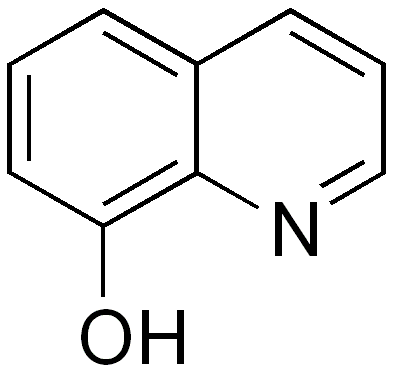

A 8 - hydroxyquinoline heterocyclic quinoline derivative. Organic compound, with a placement of an OH-group on carbon number 8.
This light yellow compound is widely used commercially, although under a variety of names.
The complexes as well as the heterocycle itself exhibit antiseptic, disinfectant, and pesticide properties,
functioning as a transcription inhibitor.
Its solution in alcohol is used as liquid bandages.
It once was of interest as an anti-cancer drug.
The result of the reaction of 8 - hydroxyquinoline and aluminium is Alq3, which is a common component of organic light-emitting diodes.
The roots of the invasive plant Centaurea diffusa release 8-hydroxyquinoline, which has a negative effect on plants that have not co-evolved with it.
Hydroxyquinoline was used as a stabilizer of hydrogen peroxide.

Chemical formula: C9H7NO
Molar mass: 145.16 g/mol
Appearance: white chtistal pins
Density: 1.034 g/cm3
Melting point: 76 °C
Boiling point: 276 °C
Articles:
4 hydroxyquinoline molecular formula is C9H7NO. The other names of 4 hydroxyquinoline is KYNURINE, AKOS 222-32, 4-QUINOLINOL, QUINOLIN-4-OL, 4(1H)-QUINOLINONE, 1H-Quinolin-4-one, 4-HYDROXYQUINOLINE, 4-hydroxy-quinolin, QUINOLIN-4(1H)-ONE, 4-hydroxyquatolate.
Both of oxine, and their complexes have antiseptic, disinfectant and insecticidal effect.
Against small burn injuries is used to in liquid bandages, which protected the wound from infection.
8-hydroxyquinoline sulphate have fungus disase against effect. It is used to athlete’s foot, and for threatment of vaginitis. 8-hydoxyquinoline compounds are component of throat- and nose rinsing liquids.